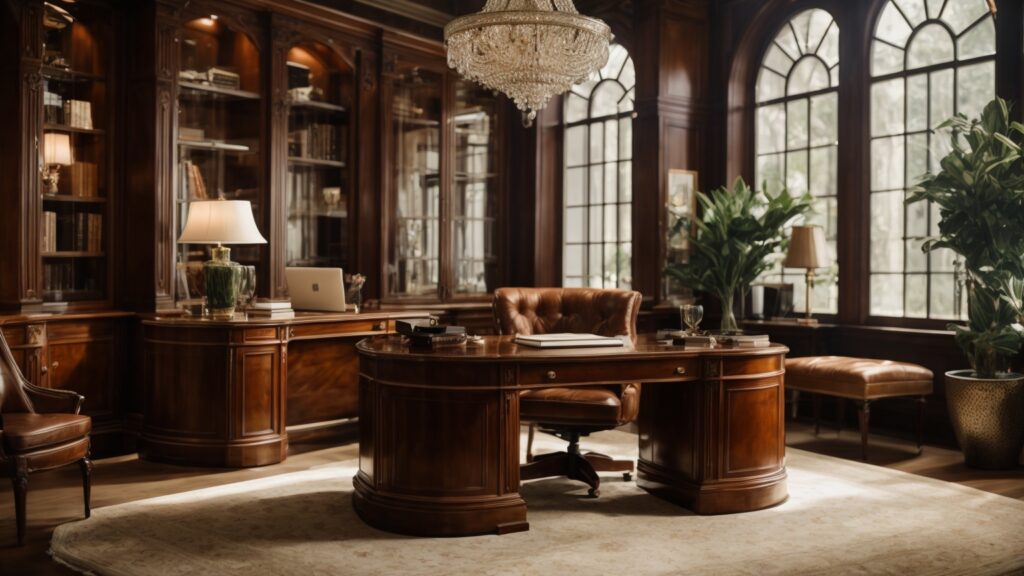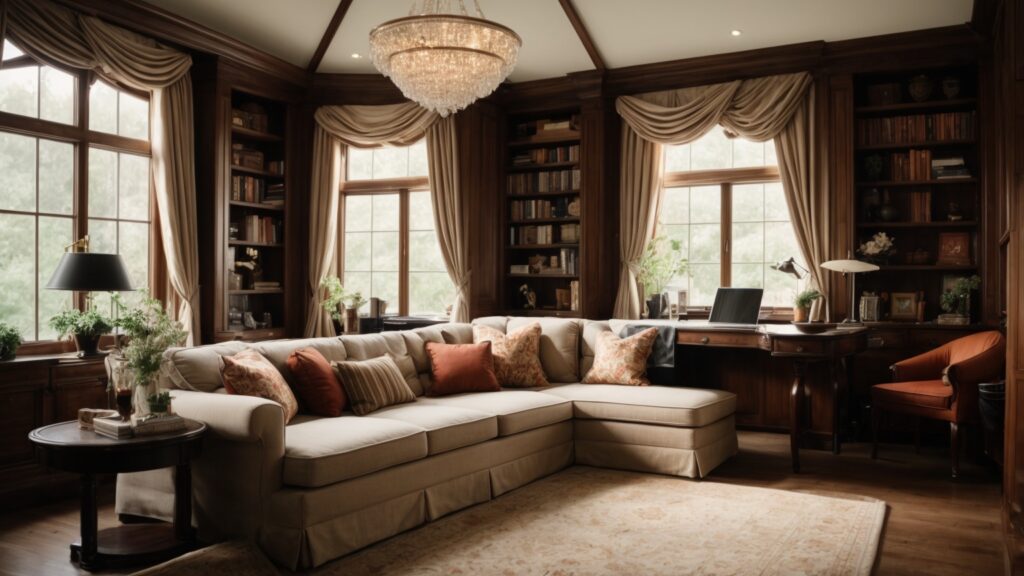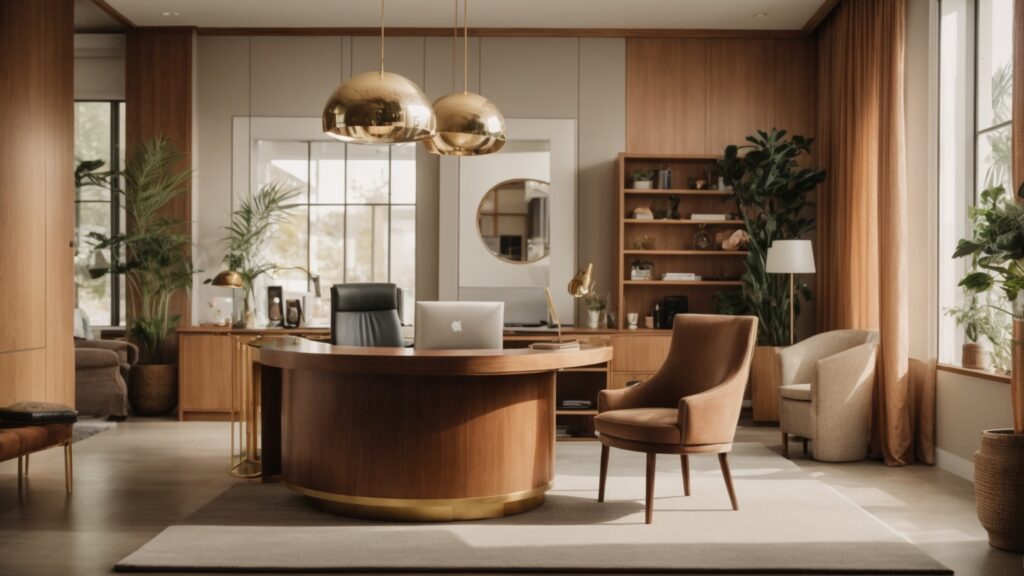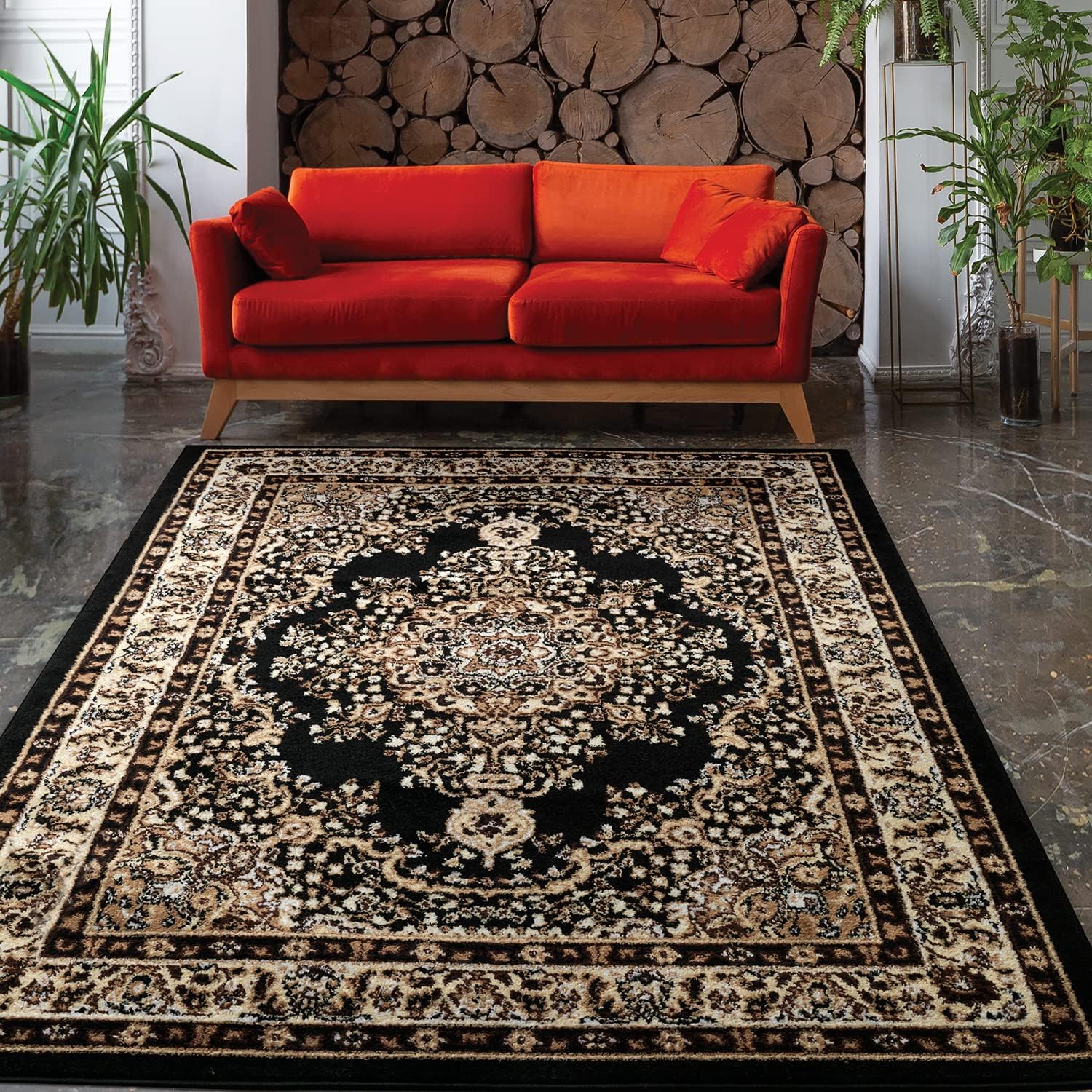Estimated reading time: 20 minutes
Introduction
Designing a traditional home office combines functionality with a touch of personal style, making it both a comfortable and efficient place to work. Home office design ideas often emphasize the need for a traditional look, blending classic decor elements with modern needs to create a space that’s not only aesthetically pleasing but also highly functional. The rich, dark wood of an oak desk, paired with a comfortable desk chair and elegant wallpaper, sets the foundation for a workspace that reflects sophistication and timeless appeal.
Incorporating elements like a stylish accent chair, area rugs, and sconces adds to the overall elegance of the office, enhancing its traditional home office design ideas. The thoughtful arrangement of key pieces such as bookshelves and paneled walls contributes to the home decor, while pops of color and traditional art provide visual interest and a personal touch. Practical yet stylish, the office also includes modern versions of classic designs, ensuring that the space is both warm and inviting and equipped for working from home. This approach not only enhances the home office feel but also makes it a truly personalized and inspiring place to work.
Key Takeaways
- Traditional Design Meets Modern Needs: Combining classic aesthetics with contemporary functionalities creates a balanced traditional home office.
- Elegant and Professional: Using rich wood tones and elegant furniture in traditional home office designs enhances sophistication and professionalism.
- Creative Space Utilization: Innovative space-saving solutions are key in small traditional home offices.
- Furniture Selection: Timeless furniture pieces are crucial for maintaining the traditional appeal in home office design.
- Efficiency through Organization: Effective departmental segregation in a home office leads to enhanced productivity.
- Incorporating Reception Areas: A well-designed reception area adds a welcoming touch to a traditional home office.
- The Role of a Pantry: Integrating a pantry into the home office design offers practicality and convenience.
- Interior Design Importance: A thoughtful interior design approach is essential for creating a functional and inviting traditional home office space.
The Appeal of Traditional Home Office Design: A Blend of Comfort and Elegance
The traditional home office blends comfort and lasting style. It’s a place where old charm and today’s work needs come together. This makes a space that inspires and helps us work better. This style is more than just about looks. It shows off personal taste and follows time-tested design rules for both beauty and use.
When setting up this kind of office, think about more than just how it looks. Make sure it feels good to work in and uses light well. This helps you stay well and focused. Picking furniture is key. It should look good forever, be comfy, and make the best use of space. For example, put the desk where it helps the room flow and choose storage that keeps things tidy.
This style also mixes old looks with the need for modern tech without losing its classic vibe. Adding your own touch with things like wall art and a comfy yet stylish chair makes the office truly yours. It keeps the best of old designs while being fully functional for today.
Design Elements That Make Traditional Home Offices Appealing
- Rich Wood Tones: Using dark wood in furniture and paneling adds warmth and sophistication.
- Elegant Furniture: Time-honored pieces like traditional desks, leather chairs, and bookshelves.
- Decorative Accents: Classic decor items, including lamps, rugs, and artwork, enhance the aesthetic appeal.
- Symmetrical Layout: A balanced arrangement of furniture and decor creates a sense of order and elegance.
- Natural Light and Window Treatments: The interplay of natural light and elegant window treatments adds depth and character.
- Sophisticated Color Palette: Colors that evoke a sense of tradition and comfort, often featuring darker hues or muted tones.
- Gallery Wall or Art Displays: Showcasing personal style through curated art collections or family heirlooms.
- Personal Touches: Incorporating items that reflect personal history and preferences, making the space uniquely yours.
Historical Influences on Traditional Home Office Design
Traditional home office design is deeply rooted in history, drawing inspiration from various eras such as the Victorian period, the Renaissance, and even elements of classical architecture. These influences are evident in the ornate details, the emphasis on craftsmanship, and the preference for materials that age gracefully. The historical context adds depth to the design and tells a story, making the home office a space rich in character and history.
Comparison of Traditional and Modern Home Office Designs
| Aspect | Traditional Home Office | Modern Home Office |
|---|---|---|
| Design Philosophy | Emphasizes elegance and time-honored aesthetics | Focuses on minimalism and contemporary trends |
| Furniture Style | Ornate, heavy wooden furniture | Sleek, lightweight, often with industrial elements |
| Color Scheme | Rich, deep tones and warm hues | Neutral or bold, often with high contrast |
| Decorative Elements | Classic art, detailed rugs, and decorative lamps | Abstract art, geometric patterns, and modern lighting |
| Layout | Symmetrical and structured | Open and flexible |
Elegance and Professionalism in Traditional Design
A traditional home office combines style and hard work. It’s all about looking good while being a place you can get serious work done. It cares about details, uses high-quality materials, and follows design rules to make a space that looks great and helps you work better.
This home office is where style, comfort, and being professional meet. It features dark wood, timeless furniture, and personal decorations that show who you are. It’s shaped by history, making it a place that works well, looks beautiful, and feels welcoming.

Navigating the Challenges: Cons of Traditional Office Space
While traditional home office designs offer elegance and a timeless appeal, they also come with challenges. These challenges often involve adapting historical design elements to modern work needs and lifestyles. Addressing these issues, from space limitations to balancing old-world charm with contemporary functionality, is crucial for creating a practical and enjoyable workspace.
Case Study: Consider the case of John, a graphic designer who recently transitioned to a traditional home office setup. He loved the aesthetic of dark wood furniture and rich color palettes but soon faced difficulties with limited space and outdated storage solutions. His struggle to integrate modern technology elegantly into the traditional design highlighted common challenges in such environments.
Overcoming Space Limitations in Traditional Designs
Traditional office spaces, particularly in older homes, frequently face the challenge of limited space, as these rooms were not initially intended for work purposes. A key strategy to address this issue is effectively utilizing vertical space, such as installing tall bookshelves that maximize storage without occupying much floor area. Another solution is choosing furniture that serves multiple purposes, for example, a desk that can also offer storage options or a convertible piece that can be used both for work and as a meeting space.
Additionally, incorporating hidden storage solutions into traditional furniture designs can significantly enhance the functionality of the space. These approaches help overcome spatial constraints and maintain the aesthetic integrity of traditional office design.
Common Challenges in Traditional Office Spaces
- Limited Space: Especially in historical homes with smaller rooms.
- Inadequate Lighting: Traditional designs may not consider the need for bright, task-oriented lighting.
- Difficulty Integrating Modern Technology: Balancing the aesthetic of traditional design while incorporating modern tech can be challenging.
- Acoustic Issues: Older homes might lack sound insulation, making private calls or concentration difficult.
- Ergonomics: While beautiful, traditional furniture may not always provide the ergonomic support needed for long work hours.
Balancing Tradition and Modern Needs
Creating a traditional home office that fulfills modern work requirements necessitates a delicate balance between the old and the new. This balance is achieved by integrating ergonomic features into traditional furniture styles, enhancing comfort without compromising the classic aesthetic. Additionally, ensuring adequate modern lighting is essential; it must be implemented in a manner that complements, rather than clashes with, the traditional decor.
Furthermore, the seamless incorporation of technology is crucial in maintaining the traditional aesthetic while providing the functionality needed in today’s work environment. This approach allows for a harmonious blend of tradition and modernity, creating a functional and elegantly timeless workspace.
Cost Implications of Traditional Office Design
Opting for a traditional office design can have significant cost implications. Authentic traditional furniture and decor often come with a higher price tag, and custom solutions to integrate modern functionalities can add to the expense. However, these costs can be mitigated by mixing genuine antiques with high-quality reproductions and implementing smart, budget-friendly design strategies.
While traditional home office designs exude elegance and charm, they present unique challenges like space limitations, integration of modern technology, and cost considerations. Successfully navigating these challenges involves creative solutions and a balanced approach to preserving the traditional essence while catering to contemporary needs.
Space-Saving Solutions: Designing a Small Yet Functional Traditional Home Office
Designing a small yet functional traditional home office requires innovative space-saving solutions that do not compromise the classic aesthetic. The challenge lies in creating a workspace that is practical for modern needs and faithful to the traditional style, characterized by rich wood tones, elegant furniture, and sophisticated decor.
Creative Use of Space: Ideas and Inspirations
Creative thinking and strategic planning are essential in the quest to maximize space in a small traditional home office. One innovative idea is converting an unused closet into a compact office nook, effectively transforming an underutilized area into a functional workspace. Another approach is utilizing corners to their full potential by designing a custom corner desk that fits snugly into the space, providing ample workspace without overwhelming the room. Additionally, installing wall-mounted shelves above the desk offers a practical storage solution, allowing for additional organization and accessibility without encroaching on valuable floor space. These ideas enhance functionality and maintain the aesthetic integrity of a traditional home office.
Multi-functional Furniture: Maximizing Space
In a small traditional home office, selecting multi-functional furniture is crucial for maximizing space efficiently. Fold-down desks are an excellent example, as they can be folded away when not in use, freeing up valuable space. Storage ottomans serve a dual purpose, functioning as both seating and storage units, offering a smart solution for clutter-free organization. Additionally, built-in cabinetry can be customized to provide both storage and display space, seamlessly blending with the traditional aesthetic of the room. These furniture choices save space and maintain the elegant and classic look characteristic of traditional home office designs.
3 Innovative Space-Saving Solutions
- Murphy Beds with Desk Attachments: Ideal for dual-purpose rooms, allowing the space to be used as an office by day and a guest room by night.
- Pull-Out Desk Surfaces: Hidden desk surfaces that can be extended when needed, saving space while providing a full-size workspace.
- Vertical Organizers: Using vertical space effectively with organizers that keep office supplies accessible but out of the way.
Space-Saving Furniture and Accessories
| Furniture/Accessory | Description |
|---|---|
| Wall-Mounted Desk | A desk can be folded up against the wall when not in use. |
| Ladder Shelf | A sleek, vertical storage solution that takes minimal floor space. |
| Convertible Sofa Bed | A sofa that converts into a bed, perfect for a multi-use space. |
Design Tips for Small Traditional Home Offices
When designing a small traditional home office, meticulous attention to detail can significantly impact the perception of space. Implementing lighter color palettes is a key strategy; lighter shades have the ability to make the room feel larger and more open. Strategic lighting is also crucial; it should be sufficient to brighten the space, thus creating an illusion of expansiveness. Additionally, the strategic placement of mirrors can effectively amplify light and create a sense of depth, making the office appear more spacious. When applied thoughtfully, these design tips can transform a small area into a seemingly larger and more inviting traditional home office.
“As an interior designer, I often recommend using reflective surfaces and light colors in small spaces. Mirrors and glass-top desks can visually expand a traditional home office, making it feel more spacious and inviting.” – Max Smart, Interior Designer
Designing a small yet functional traditional home office is about smart space utilization, choosing multi-functional furniture, and maintaining the classic aesthetic. Each element plays a crucial role in creating an efficient and stylish workspace, from innovative furniture solutions to design tips that enhance the perception of space.

Furniture Selection: Choosing Timeless Pieces for Your Traditional Home Office
Selecting the right furniture is crucial in designing a traditional home office that is both functional and aesthetically pleasing. Timeless pieces embodying traditional design elements create a sophisticated and elegant workspace and ensure longevity and durability. The focus here is on selecting furniture that resonates with the traditional style, enhancing the room’s overall appeal and functionality.
Timeless Furniture Pieces Suitable for Traditional Home Offices
- Solid Wood Desk: A centerpiece that epitomizes traditional design, offering durability and classic elegance.
- Leather Swivel Chair: Combines comfort and style, adding a touch of sophistication to the office.
- Wooden Bookshelves: Essential for organization and display, adding warmth and character to the room.
- Vintage Armchair: A cozy addition for reading or contemplation, enhancing the room’s inviting appeal.
- Antique Gallery Wall: Personalizes the space with a collection of art or family heirlooms, reflecting personal history and taste.
Evaluating Quality and Craftsmanship
Quality and craftsmanship are key in traditional home office furniture. Look for well-constructed pieces made from high-quality materials like solid wood, with attention to detail in joinery and finishes. These pieces add to the room’s aesthetic and stand the test of time, making them worthwhile investments.
Integrating Contemporary Comfort with Traditional Aesthetics
While traditional aesthetics are important, integrating contemporary comfort is essential. Ergonomically designed chairs and desks, adjustable lighting, and sufficient storage options ensure the workspace is comfortable and practical, blending the best of traditional design with modern functionality.
“A well-chosen piece of furniture can transform a traditional home office from simply a place of work to a sanctuary of productivity and style. It’s about finding that perfect balance between aesthetic appeal and functional comfort.” – Johnathon Scintone, Furniture Expert.
Selecting timeless furniture pieces for a traditional home office involves focusing on quality, craftsmanship, and blending traditional aesthetics with modern comfort. From solid wood desks to leather swivel chairs and vintage armchairs, each piece contributes to creating a functional and elegantly timeless space. Integrating these elements thoughtfully ensures a workspace that is productive and a testament to classic design principles.
Departmental Segregation in Home Office: Organizing for Efficiency
Efficient organization in a traditional home office is key to productivity, and departmental segregation is vital. It involves creating designated areas or zones within the office that cater to different functions or activities, streamlining work processes, and enhancing focus.
Ideas for Effective Departmental Segregation
- Designated Work Zones: To minimize distractions, create specific areas for different work tasks.
- Physical Dividers: Use bookshelves or screens to visually and functionally separate different sections.
- Color Coding: Utilize different color schemes to distinguish between various departments or work areas.
- Multi-Functional Furniture: Select furniture that can serve multiple purposes, such as a desk offering storage solutions.
- Technology Stations: Set up specific areas for technology, like a printing station, to keep equipment organized.
The Role of Design in Enhancing Productivity
The design of a home office plays a critical role in enhancing productivity, particularly when it comes to departmental segregation. Effective design involves creating a layout that allows for an organized workflow. This includes strategically placing natural light sources, selecting ergonomic office furniture, and thoughtful arrangement of the workspace. These design choices contribute to an environment that supports focus and efficiency, making the home office productive.
“Departmental segregation in a home office is not just about physical space. It’s about creating a mental zone that helps in compartmentalizing different tasks, which is essential for productivity,” says Dr. Emily Johnson, an organizational psychologist.
Tips for Effective Segregation in Small Spaces
Effective departmental segregation in small home offices calls for innovative and creative solutions. Utilizing vertical storage is a smart way to maximize limited space. Investing in convertible furniture that can adapt to various needs and tasks can also be highly beneficial. Additionally, clearly labeling storage areas is crucial in maintaining order and ensuring every item has a designated place. These approaches help overcome the challenges of small spaces, ensuring an organized and efficient work environment.
Innovative Storage Solutions
Innovative storage solutions are essential for maintaining organization in a segregated home office. Built-in shelving, customized to fit the space, can offer ample storage while keeping in line with the traditional design style. Furniture with hidden compartments provides additional storage options without adding clutter to the workspace. Wall organizers are another effective solution, keeping essential tools and documents accessible yet off the work surfaces. These storage solutions contribute significantly to keeping the home office organized and functional.
Effective departmental segregation in a traditional home office is key to maintaining organization and enhancing productivity. By creating designated work zones, using multi-functional furniture, and implementing innovative storage solutions, a well-segregated office can cater to various needs while preserving the elegance and style of traditional design.
Welcoming Spaces: Incorporating a Reception Area in Your Home Office
Incorporating a reception area into a traditional home office can significantly enhance its functionality and aesthetic appeal. This space, typically the first point of contact for clients or guests, sets the tone for the entire office. Designing a welcoming reception area in a home office requires a thoughtful blend of professional and personal elements, ensuring it reflects both the business’s ethos and the homeowner’s personal style.
Ideas for Creating a Welcoming Reception Area
| Element | Idea |
|---|---|
| Seating | Comfortable armchairs or a small sofa provide a relaxed atmosphere. |
| Lighting | Warm, inviting lighting that creates a welcoming ambiance. |
| Decor | Art pieces or a gallery wall that reflects personal style and professionalism. |
| Reception Desk | A traditional-style desk elegantly blends with the home’s overall decor. |
| Accessories | Decorative elements like plants or books add a personal touch. |
Balancing Personal and Professional in Reception Design
Designing a reception area in a traditional home office involves carefully balancing personal and professional elements. It’s about creating a space that is inviting, comfortable, and reflective of professional standards. Using traditional design elements, like dark wood furniture and classic decor, helps maintain a professional look, while personal touches like family photos or unique art pieces add warmth and character to the space.
“A well-designed reception area can transform a home office from a mere workspace to a professional hub. It’s about creating an environment that is welcoming yet reflects a strong professional ethos,” says Jane Williams, a hospitality expert.
Case Study: John Anderson, a freelance consultant, transformed a section of his living room into a reception area for his home office. He chose a traditional design with a modern twist, incorporating a sleek, dark wood desk and comfortable seating. The area is now not only a space to welcome clients but also a showcase of his professional brand, blended seamlessly with his home’s overall style.
Creating a welcoming reception area in a traditional home office is about balancing personal and professional elements. Thoughtful design choices, from furniture selection to lighting and decor, play a crucial role in setting the tone for the office. A well-designed reception area welcomes guests and enhances the home office’s functionality and aesthetic appeal, making it a professional and inviting space.

The Role of Pantry in Traditional Home Office Design
Incorporating a pantry into a traditional home office’s design can significantly enhance functionality and comfort. A pantry provides a convenient solution for storing snacks, drinks, and other essentials, making it easier to manage work and breaks efficiently within the workspace. This addition is especially useful in today’s hybrid working environment, where the home office often serves multiple roles.
3 Ideas for Integrating a Pantry into a Home Office
- Custom Cabinetry: Design tailor-made cabinets that blend with the traditional style of the home office, offering both storage and aesthetic appeal.
- Office Nook Conversion: Transform an unused nook or corner of the office into a compact pantry area, maximizing available space.
- Hidden Pantry Solutions: Utilize clever design solutions like pull-out drawers or hidden compartments within existing furniture for seamless pantry integration.
Design Considerations for Home Office Pantries
When designing a traditional home office pantry, it’s important to consider both functionality and style. The pantry should complement the office’s existing decor with elements like dark wood or traditional design features. It should be easily accessible and well-organized, with clear sections for different items. Proper lighting and ventilation are also key to maintaining a comfortable environment.
Case Study: Sarah, a graphic designer, recently added a pantry to her traditional home office. She opted for custom-built shelving that matched her dark wood desk, creating a cohesive look. The pantry provided convenient storage for her workday essentials and enhanced the overall appeal of her workspace, blending functionality with traditional home office style.
The Importance of a Well-Organized Pantry
A well-organized pantry in a home office is essential for maintaining efficiency and reducing distractions. It should offer easy access to items without cluttering the work area. Storage solutions like labeled bins and clear containers can help keep the pantry tidy and ensure everything is in its place.
Space-Saving Pantry Solutions
In smaller home offices, space-saving pantry solutions are vital. This can include wall-mounted shelves, under-desk storage units, or multi-purpose furniture that incorporates storage space. These solutions help maintain the traditional aesthetic while ensuring the pantry does not take up valuable work area.
Integrating a pantry into a traditional home office is a practical addition that enhances convenience and style. From custom cabinetry to hidden pantry solutions, the design should align with the office’s traditional aesthetics while serving the functional needs of the workspace. A well-organized and strategically placed pantry can significantly improve the usability and comfort of the home office environment.
- 5x7 Traditional Medallion
- Indoor Area Rug
- Siesta (Black Beige, 5'3" x 7')
Conclusion
In designing a traditional home office, it’s essential to combine traditional home office ideas with design inspiration that meets today’s needs. The integration of wooden desks, decorative floor lamps, and upcycled furniture enhances both functionality and style. Window treatments to allow natural light, coupled with the strategic use of dark walls, create a work space that is both inviting and conducive to productivity. This space not only serves functional needs with its home office ideas but also reflects personal style through decorating ideas that add character and warmth.
Ensuring the home office is equipped with comfortable office chairs and corner units maximizes space utilization and maintains a professional atmosphere. Decorilla elements and pendant lights add a modern touch to the traditional home office, illustrating how best home office ideas can be seamlessly integrated into a classic design framework. The traditional look is maintained while incorporating modern elements such as mix and match decor items, proving that traditional home office design can evolve without losing its timeless appeal.
James Dunnington leads the James Dunnington Collection, featuring five unique blogs: a practical Pet Care Guide, an enlightening Ancient History Blog, a resourceful Home Improvement Guide, a cutting-edge Tech Innovation Guide, and a strategic Online Money Making platform. Each site delivers valuable insights designed to empower and inform. For updates and more tips, visit our Contact Us page to sign up for our newsletter, ensuring you never miss out on the latest content from any of these dynamic fields.

